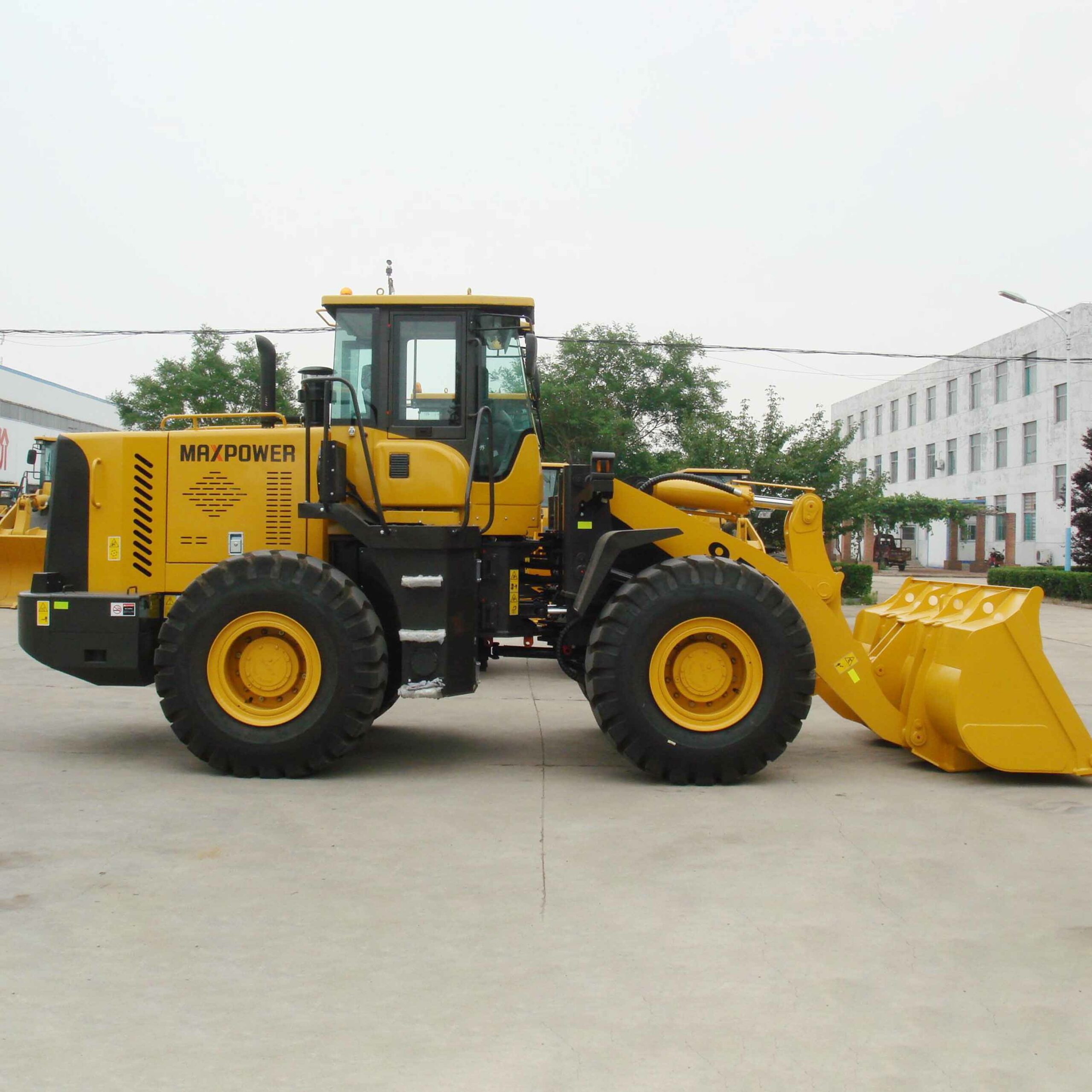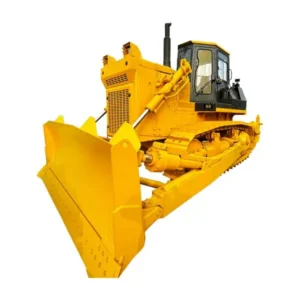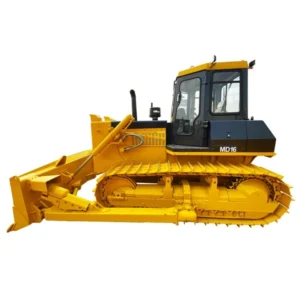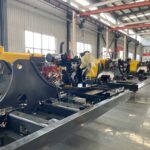Introduction
Snow dozers have become an essential part of winter maintenance in regions where snowfall is common. They are primarily used by municipalities, transportation departments, and private entities responsible for snow removal. Snow dozers enable efficient and timely clearance of snow, ensuring smooth traffic flow and safe pedestrian access.
What are Snow Dozers?

Snow dozers, also known as snow pushers or snow plows, are specialized machines designed specifically for the purpose of removing snow and clearing pathways during winter weather conditions. These powerful vehicles play a crucial role in maintaining safe and accessible roads, parking lots, sidewalks, and other areas that are affected by heavy snowfall.
Snow dozers are typically equipped with a large blade, usually made of sturdy steel, which is mounted on the front of the vehicle. This blade is adjustable and can be angled to effectively push the snow either to the side or directly ahead. The size of snow dozers can vary significantly, ranging from compact models designed for smaller areas to large industrial-grade machines capable of handling heavy-duty snow removal tasks.
These machines have come a long way in terms of their design and capabilities. In the early days of snow removal, horse-drawn plows were manually operated to clear snow from roadways. However, as the 20th century progressed, motorized vehicles started to replace horse-drawn plows, leading to the mechanization of snow dozers. Over time, advancements in technology and engineering have further improved the efficiency and effectiveness of snow dozers.
One of the key components of snow dozers is the blade itself. The blade is the most crucial part of the machine and is responsible for pushing and removing the snow. It is designed to be strong and durable, capable of withstanding the heavy loads and resistance encountered during snow removal operations.
In addition to the blade, snow dozers are equipped with various other components and systems that contribute to their functionality. Hydraulic systems play a vital role in providing the necessary power and control for the movement of the blade. The powertrain, which typically consists of an engine and transmission, ensures that the machine has sufficient power and torque to handle the snow removal tasks efficiently.
Snow dozers also feature an operator cabin where the driver controls the machine’s movements and operations. The cabin is designed to provide comfort and safety for the operator during long hours of operation in cold and harsh weather conditions. The controls, such as levers and joysticks, allow the operator to adjust the blade’s position and angle as needed.
Moreover, snow dozers are equipped with lighting systems to ensure visibility during nighttime or low-light conditions. These lighting systems are essential for the safety of both the operator and other vehicles or pedestrians in the vicinity.
Overall, snow dozers are specialized machines that have revolutionized the process of snow removal. Their robust design, adjustable blades, and powerful hydraulic systems enable efficient and timely clearance of snow, ensuring safe transportation and pedestrian access even in the most challenging winter weather conditions.
History of Snow Dozers
The history of snow dozers dates back several centuries, with the need for snow removal becoming increasingly apparent as civilizations expanded and encountered snowy climates. In the early days, snow removal was a labor-intensive process that relied on manual labor and simple tools like shovels and hand-held plows.
The mechanization of snow removal began to take shape in the early 20th century. Prior to this, horse-drawn plows were used to clear snow from roadways. However, as the industrial revolution gained momentum, motorized vehicles started to replace their horse-drawn counterparts, leading to significant advancements in snow removal technology.
The first mechanized snow plows were mounted on trucks and were operated by a single driver. These early snow plows were rudimentary in design but represented a significant leap forward in snow removal efficiency. They were typically equipped with a straight blade mounted on the front of the vehicle, which was manually controlled by the driver.
As the technology evolved, hydraulic systems were introduced, enabling operators to adjust the angle and position of the blade more easily. This innovation allowed for greater precision and control during snow removal operations. Hydraulic systems also enhanced the overall efficiency of snow dozers by providing the power necessary to push larger amounts of snow.
In the mid-20th century, advancements in engine technology, such as the introduction of more powerful and fuel-efficient engines, further improved the performance of snow dozers. These advancements allowed for increased speed and enhanced maneuverability, enabling snow removal crews to clear larger areas in less time.
Over the years, manufacturers began to produce specialized snow dozers designed explicitly for heavy-duty snow removal operations. These machines featured reinforced frames, stronger blades, and more robust hydraulic systems, allowing them to tackle even the most challenging snow removal tasks.
The introduction of snow dozers revolutionized the snow removal industry, making it more efficient and less labor-intensive. Snow dozers enabled municipalities, transportation departments, and private entities to clear roads, parking lots, and other essential areas more quickly and effectively, ensuring the safety and accessibility of these spaces during winter weather conditions.
In recent years, snow dozer technology has continued to evolve. Manufacturers have incorporated more advanced features into their machines, such as ergonomic operator cabins, enhanced visibility systems, and improved blade designs. These innovations have further increased the efficiency and ease of operation for snow dozers, making snow removal processes more streamlined and effective.
Looking to the future, ongoing advancements in technology and engineering will likely lead to further improvements in snow dozer design and functionality. As the demand for efficient snow removal continues to grow, we can expect to see even more innovative solutions that will enhance the performance and environmental sustainability of snow dozers.
Components of Snow Dozers
Snow dozers consist of several key components that work together to ensure effective snow removal and clearing operations. Each component plays a vital role in the functionality and performance of the machine. Let’s take a closer look at these components:
Blade: The blade is the most crucial component of a snow dozer. Typically made of durable steel, the blade is mounted on the front of the machine and is responsible for pushing and clearing the snow. The size and shape of the blade can vary depending on the specific snow dozer model and the intended use. Some blades are straight, while others are curved or V-shaped to optimize snow removal efficiency.
Hydraulic Systems: Snow dozers utilize hydraulic systems to provide power and control for the movement of the blade. Hydraulic cylinders and pumps are responsible for adjusting the angle, height, and position of the blade. These systems enable precise control and quick adjustments, allowing operators to adapt to varying snow conditions and terrain.
Powertrain: The powertrain of a snow dozer consists of an engine and a transmission. The engine generates the power necessary to operate the machine, while the transmission transmits this power to the wheels or tracks, enabling movement. Snow dozers can be powered by diesel engines or, in some cases, electric motors, providing the necessary torque and traction required for effective snow removal.
Operator Cabin: The operator cabin is the control center of the snow dozer. It provides a comfortable and safe working environment for the operator during long hours of operation in harsh weather conditions. The cabin is equipped with ergonomic controls, an adjustable seat, and climate control systems to enhance operator comfort and productivity. Clear visibility through the cabin windows is essential for safe and efficient operation.
Controls: Snow dozers feature various controls that enable the operator to maneuver the machine and adjust the blade position. These controls can include joysticks, levers, pedals, and switches, allowing the operator to raise or lower the blade, angle it to the desired position, and control the machine’s speed and direction of movement. Intuitive and ergonomic control placement is crucial for operator convenience and precise snow removal operations.
Lighting Systems: Snow dozers are often equipped with lighting systems to ensure visibility in low-light or nighttime conditions. Powerful headlights and additional lights mounted on the machine improve visibility for the operator and enhance safety during snow removal operations. Good visibility is crucial for identifying potential obstacles, pedestrians, or other vehicles in the vicinity.
Safety Features: Snow dozers incorporate various safety features to protect the operator and those around the machine. These features can include seat belts, rollover protection structures (ROPS), backup alarms, and emergency stop switches. Additionally, some snow dozers are equipped with cameras or proximity sensors to assist the operator in avoiding collisions and maintaining situational awareness.
Attachments and Accessories: Snow dozers can be equipped with additional attachments and accessories to enhance their functionality. These can include salt spreaders, de-icing systems, brushes, or blowers, depending on the specific needs of the snow removal operation. These attachments enable the snow dozer to handle a wider range of snow conditions and improve overall efficiency.
Each of these components contributes to the overall performance and effectiveness of snow dozers in snow removal operations. The integration of these components allows snow dozers to efficiently clear snow, maintain safe pathways, and ensure the smooth flow of traffic in winter weather conditions.
Types of Snow Dozers
Snow dozers come in various types and configurations, each designed to cater to specific snow removal needs and operating conditions. Let’s explore some of the common types of snow dozers:
- Standard Snow Dozers: Standard snow dozers are the most common type and are widely used for general snow removal tasks. They typically feature a straight blade mounted on the front of the machine and are suitable for clearing snow from roads, parking lots, sidewalks, and other flat surfaces. Standard snow dozers come in different sizes and power options to accommodate various snowfall levels and operating requirements.
- V-Plows: V-plows, as the name suggests, have blades in a V-shape configuration. These snow dozers offer versatility and increased efficiency in clearing snow. The V-plow design allows operators to direct snow to the sides more effectively, creating a path wider than the machine itself. This type of snow dozer is particularly useful for clearing wide roads, open areas, and intersections.
- Pusher Snow Dozers: Pusher snow dozers, also known as box plows, are specifically designed for pushing large volumes of snow. They feature a wide and low-profile box-shaped blade that can efficiently move snow to the side. Pusher snow dozers are often used in areas with heavy snowfall or when dealing with deep accumulations. These machines excel in clearing large parking lots, storage areas, and expansive commercial properties.
- Wing Plows: Wing plows, also called angle plows or winged snow dozers, are designed to extend their clearing width beyond the width of the machine itself. They consist of a center blade and two wing blades that can be independently adjusted. This configuration enables operators to clear a wide area in a single pass. Wing plows are commonly used in highway maintenance and other applications where maximizing efficiency and reducing the number of passes is crucial.
- Front Loader Snow Dozers: Front loader snow dozers, or snow loaders, combine the capabilities of a snow dozer with those of a front-end loader. They feature a bucket attachment at the front, allowing for not only snow pushing but also the ability to scoop and lift snow. Front loader snow dozers are commonly used in situations where snow needs to be moved and piled, such as loading trucks or clearing large snowbanks.
- Compact Snow Dozers: Compact snow dozers are smaller-sized machines designed for clearing snow in tight or hard-to-reach spaces. They are highly maneuverable and can navigate narrow streets, sidewalks, and areas with limited access. Compact snow dozers are commonly used in urban areas, residential neighborhoods, and commercial complexes where space is limited.
- Articulated Snow Dozers: Articulated snow dozers feature a jointed frame that allows the machine to bend in the middle. This articulation improves maneuverability, enabling the snow dozer to navigate curves and obstacles more easily. Articulated snow dozers are commonly used in areas with complex terrain or when precise maneuvering is required, such as in mountainous regions or urban environments.
- Track-Driven Snow Dozers: Track-driven snow dozers, also known as tracked snow plows, replace traditional wheels with tracks, similar to those found on construction equipment. The tracks provide better traction and weight distribution, allowing for improved performance in challenging snow and ice conditions. Track-driven snow dozers are often preferred for steep slopes, icy surfaces, and areas where extra traction is necessary.
Each type of snow dozer has its own advantages and is suited for specific snow removal applications. The selection of the appropriate type depends on factors such as the size of the area to be cleared, terrain conditions, the intensity of snowfall, and the desired level of efficiency. By choosing the right type of snow dozer, snow removal operators can optimize their productivity and effectively manage winter weather challenges.
| Type of Snow Dozer | Key Features | Best Use Cases |
|---|---|---|
| Standard Snow Dozer | Basic design, front-mounted blade, compact and easy to maneuver | Residential driveways, small parking lots, sidewalks |
| V-Plow Dozer | V-shaped blade, splits snow to both sides, adjustable blade angles | Heavy snowfall, large driveways, rural roads |
| Wing Plow Dozer | Additional wing blades for increased clearing width, adjustable wings | Highways, large parking lots, airport runways |
| Box Plow Dozer | Box-shaped blade, contains and pushes snow forward, high snow containment | Commercial properties, large parking lots, loading docks |
| Rotary Snow Dozer | Rotating blade or auger, throws snow to the side, high-efficiency snow removal | Urban streets, sidewalks, areas with heavy snow accumulation |
| Compact Snow Dozer | Small and lightweight, easy to maneuver in tight spaces, front-mounted blade | Sidewalks, narrow pathways, residential areas |
| Truck-Mounted Snow Dozer | Mounted on trucks, versatile, capable of handling large areas, high mobility | Municipal snow removal, highways, large commercial areas |
| Tracked Snow Dozer | Equipped with tracks instead of wheels, enhanced traction on slippery surfaces | Steep inclines, off-road areas, ski resorts |
| Articulated Snow Dozer | Jointed frame for better maneuverability, flexible blade angles | Complex terrain, tight spaces, urban streets |
| Multi-Blade Snow Dozer | Multiple blades for various tasks, adjustable configurations | Versatile snow removal in different environments, airports |
Benefits of Using Snow Dozers
Using snow dozers for snow removal operations offers a range of benefits compared to manual or alternative methods. These machines are specifically designed to handle the challenges posed by snow and ice, providing numerous advantages in terms of efficiency, effectiveness, and safety. Let’s explore some of the key benefits of using snow dozers:
- Efficiency: Snow dozers significantly improve the efficiency of snow removal operations. With their powerful engines and hydraulic systems, they can quickly clear large amounts of snow in a single pass. Snow dozers with wider blades or specialized configurations can cover more ground, reducing the time and effort required to clear snow from roads, parking lots, and other surfaces. This increased efficiency allows for faster recovery and the restoration of normal activities during and after snowfall events.
- Productivity: Snow dozers enable higher levels of productivity compared to manual labor or alternative equipment. Their robust design and powerful performance allow operators to remove snow more effectively, leading to increased productivity and faster completion of snow removal tasks. By utilizing snow dozers, snow removal crews can cover larger areas in less time, improving overall operational efficiency.
- Versatility: Snow dozers are versatile machines that can be adapted to various snow removal needs. They come in different sizes, blade configurations, and attachments, allowing for versatility in handling different snow conditions and surface types. Whether it’s clearing snow from roads, sidewalks, parking lots, or other areas, snow dozers can be customized and equipped to meet specific requirements, providing flexibility in snow removal operations.
- Safety: Snow dozers contribute to enhanced safety during snow removal activities. By quickly and efficiently clearing snow, they help maintain safe pathways for vehicles and pedestrians. Properly cleared roads and walkways reduce the risk of accidents, slips, and falls, ensuring the well-being of the community. Snow dozers are also equipped with safety features such as lights, alarms, and visibility-enhancing systems to enhance operator safety and prevent accidents during snow removal operations.
- Reduced Manual Labor: Snow dozers significantly reduce the need for manual labor in snow removal tasks. Instead of relying solely on shovels or handheld tools, snow dozers allow for mechanized snow clearance, minimizing physical exertion and the risk of strain or injury to workers. This not only increases overall safety but also improves the working conditions for snow removal crews, reducing fatigue and allowing them to focus on other essential tasks.
- Consistency and Precision: Snow dozers provide consistent and precise snow removal results. The operator can adjust the blade’s position and angle, allowing for precise control over the snow-clearing process. This ensures uniform clearance and prevents uneven surfaces or piles of snow that could obstruct traffic or impede pedestrian movement. The ability to maintain consistent clearance levels contributes to the overall accessibility and smooth flow of transportation during winter conditions.
- Cost-Effectiveness: While the initial investment in a snow dozer may be significant, they can offer long-term cost savings. By streamlining snow removal operations and reducing the need for manual labor, snow dozers optimize resources and improve overall operational efficiency. The time saved in snow clearance translates into cost savings for municipalities, businesses, and property owners in terms of labor, equipment maintenance, and the prevention of accidents or damages caused by insufficient snow removal.
In conclusion, the use of snow dozers brings numerous benefits to snow removal operations. From improved efficiency and productivity to enhanced safety and cost-effectiveness, these machines are essential tools for effectively managing snow and maintaining safe, accessible environments during winter weather conditions.
Popular Snow Dozer Brands
Several reputable brands specialize in manufacturing high-quality snow dozers. Some popular brands in the industry include XYZ Snow Dozers, ABC Plow Systems, and SnowMaster. These brands have a strong reputation for producing reliable and durable snow dozers that meet the demands of professional snow removal operations.
How to Choose the Right Snow Dozer
Choosing the right snow dozer depends on several factors such as the size of the area to be cleared, average snowfall, terrain conditions, and budget. It’s essential to consider the blade width, engine power, maneuverability, and additional features like adjustable blades or ergonomic operator cabins. Consulting with industry experts or experienced snow removal professionals can help make an informed decision.
Maintenance and Care for Snow Dozers
Proper maintenance and care are essential for the longevity and performance of snow dozers. Regular inspections, lubrication, and cleaning are necessary to prevent rust and ensure smooth operation. The blade should be checked for any signs of damage or wear. Hydraulic systems, filters, and fluids should be maintained according to the manufacturer’s recommendations.
Safety Considerations
Operating a snow dozer requires proper training and adherence to safety protocols. Operators should wear personal protective equipment, such as high-visibility clothing and gloves. Clear communication with pedestrians and other workers is crucial, and caution should be exercised when operating near obstacles or vehicles. Regular maintenance and inspections contribute to overall safety.
Common Issues and Troubleshooting

While snow dozers are robust and reliable machines, they may encounter certain issues during operation. Understanding common problems and their troubleshooting techniques can help operators address these issues promptly and minimize downtime. Let’s explore some of the common issues that may arise with snow dozers and their possible troubleshooting steps:
Hydraulic System Leaks: Hydraulic system leaks can occur due to damaged hoses, fittings, or seals. If a hydraulic leak is detected, it is essential to stop the machine immediately and assess the source of the leak. Inspect the hydraulic lines, fittings, and connections for any signs of damage or loose connections. Replace damaged components or tighten connections as necessary. Regular maintenance and inspection of hydraulic systems can help prevent leaks and ensure optimal performance.
Engine Starting Problems: Difficulties in starting the snow dozer’s engine can be caused by various factors such as a dead battery, fuel system issues, or ignition problems. Check the battery to ensure it has sufficient charge and that the terminals are clean and properly connected. Verify that the fuel tank has an adequate supply of fuel and that the fuel filters are not clogged. If the engine still fails to start, inspect the ignition system for any faults and consult the manufacturer’s manual for specific troubleshooting steps.
Blade Malfunction: The snow dozer blade may experience issues such as getting stuck, not raising or lowering properly, or not angling correctly. Inspect the hydraulic system for any malfunctions or leaks that may be affecting the blade’s movement. Ensure that the control levers or joysticks are functioning correctly and that there are no obstructions or debris hindering the blade’s operation. If necessary, consult the operator’s manual or seek assistance from a qualified technician for blade adjustment or repair.
Track or Wheel Slippage: Track-driven snow dozers may encounter issues with track slippage or wheel traction. Inspect the tracks or wheels for any signs of wear, damage, or debris accumulation. Clean the tracks or wheels thoroughly to remove any ice, snow, or debris that may be affecting traction. Adjust the tension of the tracks or check the tire pressure to ensure optimal contact with the ground. If the issue persists, consult the manufacturer’s guidelines or seek professional assistance for further troubleshooting or adjustments.
Electrical System Problems: Electrical system problems can manifest as issues with lights, controls, or other electrical components. Check the fuses and wiring connections to ensure they are intact and secure. Test the electrical components for proper functionality, such as headlights, control switches, and safety features. If there are any faulty or damaged electrical components, replace them with the appropriate replacements recommended by the manufacturer.
Excessive Vibration or Noise: Excessive vibration or noise during snow dozer operation can indicate mechanical issues. Inspect the machine for loose or damaged components, such as bolts, fasteners, or worn-out parts. Tighten any loose connections and replace any damaged or worn-out parts as necessary. Regular maintenance and lubrication of moving parts can help minimize vibration and noise.
Lack of Power or Poor Performance: If the snow dozer exhibits a lack of power or reduced performance, it may be due to issues such as clogged air filters, fuel system problems, or engine malfunctions. Check the air filters and clean or replace them if necessary. Inspect the fuel system for any blockages or contamination and ensure the fuel is of the correct grade. If the issue persists, consult the manufacturer’s troubleshooting guide or seek assistance from a qualified technician for further diagnosis and repair.
It is important for snow dozer operators to regularly inspect and maintain their machines to prevent issues and address any problems promptly. Following the manufacturer’s recommended maintenance schedule, keeping the machine clean, and addressing minor issues early on can help ensure smooth and trouble-free operation of snow dozers during snow removal tasks.
Environmental Impact of Snow Dozers
While snow dozers are effective in clearing snow, their operation can have environmental implications. The use of de-icing agents and the displacement of large volumes of snow can impact local ecosystems and waterways. It’s important to use environmentally friendly de-icing agents and adopt responsible snow removal practices to minimize these effects.
Future Innovations in Snow Dozer Technology
Advancements in technology continue to shape the snow dozer industry. Future innovations may include autonomous or semi-autonomous snow dozers equipped with sensors and artificial intelligence for improved efficiency and safety. Electric-powered snow dozers are also being explored as a more sustainable alternative to traditional diesel-powered machines.
Conclusion
Snow dozers have a rich history and play a vital role in maintaining accessible and safe transportation routes during winter weather. Understanding their components, types, benefits, and maintenance requirements is essential for effective snow removal operations. As technology advances, we can expect further innovations in snow dozer design and environmental considerations.
FAQs
Can snow dozers be used on uneven terrain?
Yes, snow dozers are designed to handle various terrains, including uneven surfaces. However, it’s important to choose a model that suits the specific terrain conditions to ensure optimal performance.
Are snow dozers only used for clearing roads?
No, snow dozers are versatile machines that can clear snow from various surfaces, including roads, parking lots, sidewalks, airports, and other areas affected by heavy snowfall.
How often should a snow dozer be serviced?
Regular maintenance is crucial for snow dozers. It’s recommended to follow the manufacturer’s guidelines and schedule routine inspections and servicing based on the operating hours and usage.
Can snow dozers remove ice as well?
Snow dozers are primarily designed for snow removal but can be equipped with additional features like ice scrapers or de-icing systems to tackle icy conditions effectively.
Are snow dozers expensive to operate and maintain?
The cost of operating and maintaining a snow dozer depends on various factors such as fuel consumption, maintenance requirements, and the size of the machine. However, the efficiency and time-saving benefits often outweigh the costs for professional snow removal operations.









-150x150.webp)
